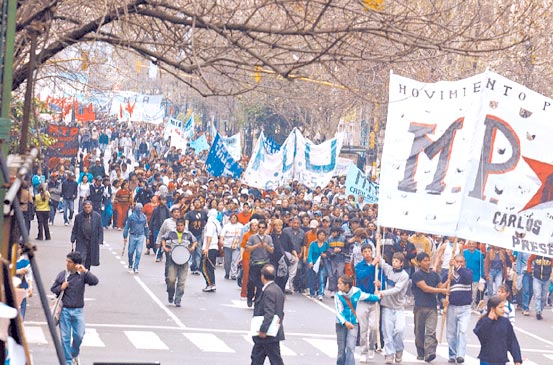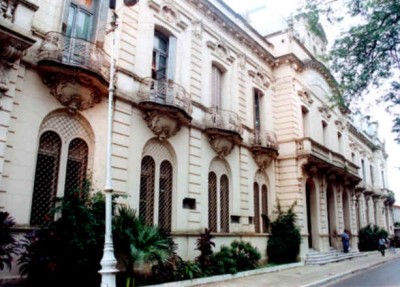
Like a lot of you mission alums, I watched with much sadness the events of 2001/2002 in Argentina. If you're not aware of these events, here's more or less what happened: During the 1980's, inflation was killing Argentina's economy, so President Carlos Menem stepped in and solved the problem by fixing the peso 1:1 to the U.S. dollar in 1991. It remained that way for over a decade. Missionaries from this time will remember being able to use dollars and pesos interchangeably almost everywhere. But Argentina's economy was not able to keep pace with the U.S. economy, and downward pressure on the peso built as time marched on. Then, in December 2001, the peso gave way and its value went tumbling down. Argentines flocked to banks to retrieve their savings in stable U.S. dollars. Unable to meet the demand for so much U.S. currency, the government froze the banking system. When things settled down after a few tense days, many middle class Argentines (quite a large group, unlike most of Latin America) found their savings to be worth 25% of their value only days before. Since nobody had any money, consumer spending fell dramatically, as did tax revenues. With less revenue and a suddenly almost worthless currency, the government was unable to keep paying back its loans and Argentina defaulted on $132 billion of debt. Chaos resulted as unemployment exceeded 30%. Riots in the streets killed several dozen people. The nation went through 5 presidents in 2 weeks. Two alternate currencies were tried, and a few provinces illegally printed their own currencies.
Things remained in this sad state for about 6 months, then Argentina began to get back on its feet. The economy began to grow again, unemployment steadily declined, and the peso stabilized. While nothing can repair the damage that was done to so many Argentines, they have proven themselves to be a nation of resolve. In fact, Argentina's GDP in 2003 was their best ever.
But life is not completely back to normal. The government is still negotiating loan repayments with investors and the World Bank, unemployment is still a bit high, and the list goes on. These things were on my mind when I was considering taking my wife to Buenos Aires. Having not been back since before the economy collapsed, I wondered if I would find the same Buenos Aires I left behind. Is the city in desrepair? Are there people starving in the streets? You might be wondering the same thing: What should I expect?
Fortunately, things are very much the same. If you don't leave Capital Federal, you probably won't even notice. You'll still see plenty of Italian suits and cell phones on downtown streets. Restaurants, nightclubs, fast food joints, and cafes are still packed. The people are just as animated as ever, and I get a real sense of optimism about the general direction of the nation. Here's a quick look at Buenos Aires today.
 Protests
Protests
Argentines have always been vocal about their troubles, but since the economic troubles it's gone to a whole new level. Protests often have several thousand people and are designed to create as much mayhem
as possible. Today's protests almost always lead to Plaza de Mayo or Congreso, and the protesters will walk down the middle of the busiest streets, tying up traffic for hours. If you spend lots of time
downtown, you're almost certain to run into at least one protest. It can be intimidating to see
thousands of seemingly angry people beating drums and chanting slogans, but before you panic, keep in
mind the following:
- Protests are almost always nonviolent, and the rare altercations are between protesters and police.
People on the street are not involved. Some protesters may carry bats and chains, but these are to
prevent cars from crossing, not to injure people.
- Protests are well publicized in advance, so there is always a major police presence. The police
allow the protesters to march in the streets, but they are not afraid to get involved if there are any
acts of violence.
- Foreigners, including Americans, are not the target of their protests. They are protesting the
government and energy-producing companies.
If you encounter a protest, don't make a big deal out of it. Simply move away or wait for the protest
to pass. They usually take less than 10 minutes. If you mind your own business, nobody will even look
your way, even if you look like an obvious tourist. The vast majority of Argentines disagree with these
protests, so there may be honking horns or shouting. Just don't worry because this is all normal.
 Crime
Crime
With all the economic troubles, it shouldn't surprise you to hear that crime is on the rise in
Argentina, but don't let that stop you from going. The crime rate is still very low compared to other
major cities -- much lower than places like New York, London, and Los Angeles. While crime has plagued
many major Latin American cities like Bogota and Rio de Janiero, this seems to have passed by Buenos
Aires, at least for now. Personally I would rather take my chances in Buenos Aires than almost any city
in America. But crime still does exist, so for your safety, following these simple tips will greatly
reduce your chances of being a victim.
- The most common crime involving tourists is pickpocketing. This occurs most often where people are
tightly packed together, such as on a crowded subte or while waiting to cross the street. The best way
to avoid this is to not carry money, cameras, etc. where they're easy to reach. Money belts work well
for carrying cash. I carry a backpack with a luggage lock for my cameras and items I've purchased.
- Armed robbery and kidnapping are less likely, but still possible, in Argentina. Lately there have
been several kidnappings of relatives of celebrities and sports stars, mostly because the kidnappers
know that large ransoms can be paid. While no tourists have been kidnapped, it could happen someday.
To avoid it happening to you, don't look like you're rich. Avoid showing large amounts of cash in
public. Leave your jewelry at home. Don't wear obviously expensive clothing, or clothing that's
obviously American (although everyone wears American shoes, so that's OK).
- Violent assaults and rape are rare in Buenos Aires, given the size of the city, but they do happen
now and then. Once again, you can greatly reduce your chances of becoming a victim by exercising some
common sense. Stay on well-traveled, well-lit roads. Try not to travel alone. Avoid
suspicious-looking individuals or groups.
- The police situation in Argentina is improving. In the old days, a policeman's salary was too
little to live on, so almost every one was taking bribes. But President Kirchner has fired over 500 of
the most corrupt policemen and has raised the salaries of the rest. Police today are more honest and
reliable, so they will be there if you should ever need them.
 The Church
The Church
While Argentina was going through its darkest days, my thoughts turned to some of the people I got to
know on my mission. So many of these incredible saints were barely getting by when things were going
well. On a trip to Buenos Aires later on, I ran into a member I knew at the temple and he related to me
how well the members of the church pulled together during that difficult time. He mentioned that those
who still had jobs were so willing to share with the less fortunate, both members and non-members. The
church welfare system was able to help thousands. He told me that many Argentines joined the church
during that time because of the assistance provided by the wards, branches, and stakes, and the gospel
continues to spread and grow stronger.
I've noticed growth in the number of children and young adults in the church in Argentina. It seems
reasonable to assume that a lot of them are children of the many converts in Argentina over the past 20
years. I don't have any statistics, but I imagine a growing number of church members were born into the
gospel. As these youth grow up, go on missions, return to form strong families, and become leaders in
the church, I think the gospel will flourish. The church in Argentina is fairly impressive, but in my
mind this is just the tip of the iceberg.
The church is not without its problems these days. Retention is still low, and the Area Presidency has
mentioned on several occasions how hard it is to keep leaders trained with so many converts in
leadership positions. But what I remember most, the strength and testimonies of the saints, lives on.
As a young missionary, I remember walking to church in a downpour one Sunday, complaining to my
companion about the miserable weather. When we stopped at an intersection, I saw a familiar figure
walking toward us through the rain - it was an old woman from the ward. She had to be at least 90, she
lived several miles from the church, and she was so poor she used to serve us raw vegetables for lunch.
She didn't own a pair of shoes. Every time she took a step with her left foot, a little bit of red
stained the wet sidewalk. When she reached us, I asked her, "why don't you stay home today? You're an
old woman, the weather is awful, and the church is miles farther. Everyone would understand if you
stayed home." She didn't stop walking but simply said, "when I was baptized, I promised my Heavenly
Father I would go to church every Sunday, and that's what I'm doing."
What a great lesson she taught me that day. Even though I towered over her by at least a foot, I
realized that, in the eyes of the Lord, she was a giant and I was less than dirt. At that moment I
promised myself that I would never complain about anything the Lord asks me to do, and I think of this
story any time I'm tempted to do so.
The Argentine saints taught me so much about what it means to truly be a disciple of the Lord, and I
think most other returned missionaries would say the same thing. You that have just been called will
learn so many valuable lessons from them as well. When you return home, you will feel eternally
grateful for the blessing of being able to serve in the Buenos Aires West mission.
Table of Contents
Visiting Buenos Aires: Main Page
Where To Stay
Where To Eat
Things To See & Do
Shopping
Transportation
Paying
B.A. Today
Useful Phrases
|

